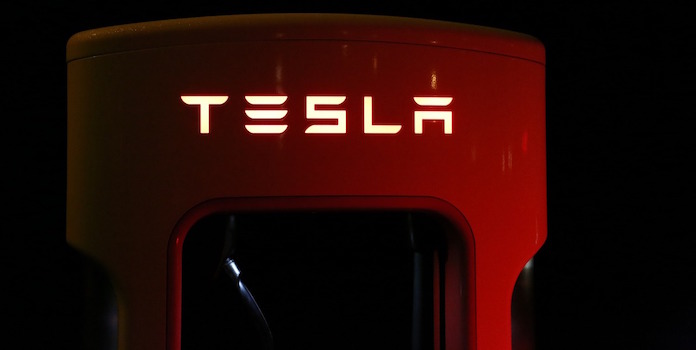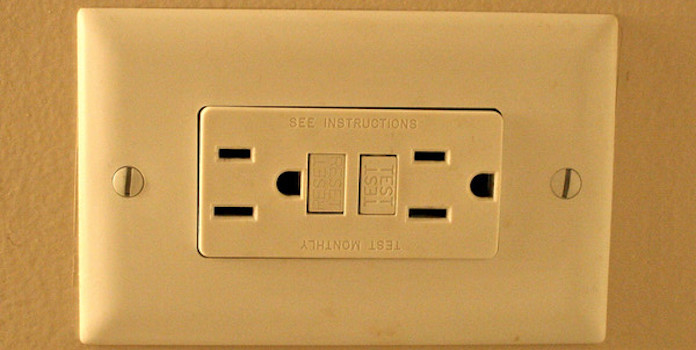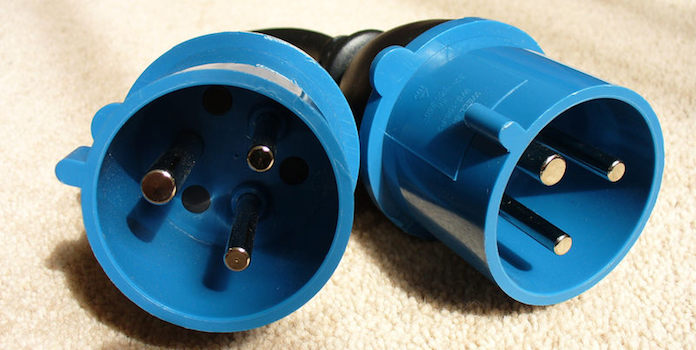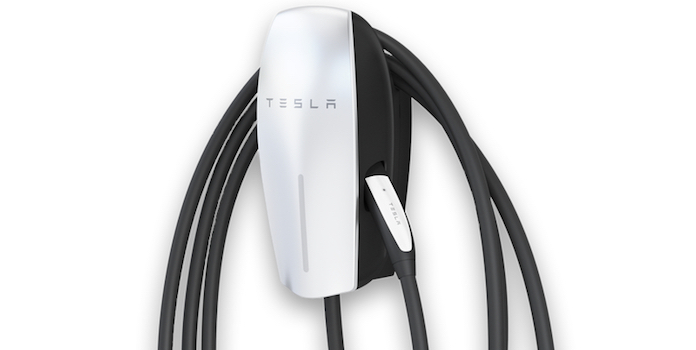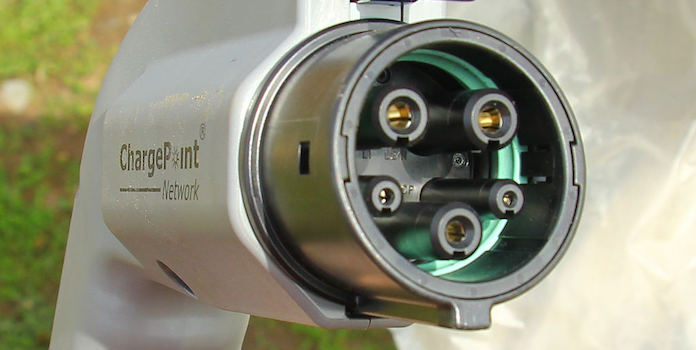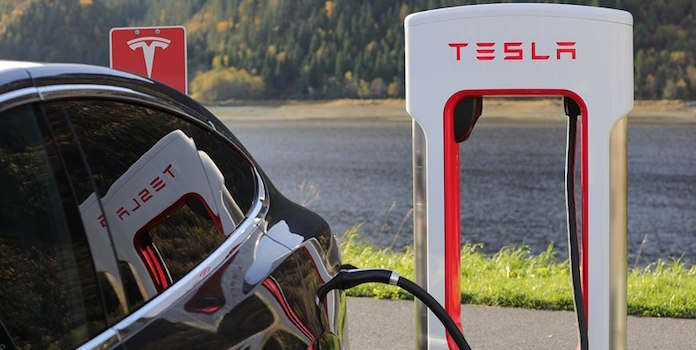Tesla Home Charger Options
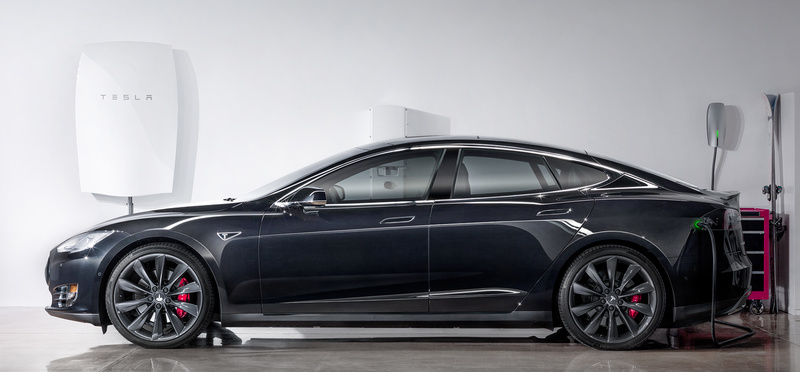
Buying a Tesla? Let’s have a look at the different Tesla charging options.
Many of us are so used to stopping at the gas station that we don’t think too far beyond that routine when it comes to powering our vehicles. But now that you are buying a Tesla, trips to the gas station are a thing of the past–you’ll be able to charge your car from the comfort of your garage with a Tesla home charger.
For those of us that might own another electric vehicle (EV), like a Nissan Leaf or a Chevrolet Volt, charging a Tesla will look a little more familiar, but there are still products and qualities unique to this brand.
The current Tesla models include a luxury sedan (Model S) and SUV (Model X), and although many homeowners still can’t afford these vehicles, Tesla is headed toward the regular market. The Model 3 is priced starting at $35,000, and enters production in July 2017 – there are already more than 400,000 people signed up to pre-order the vehicle!
So if you’re one of those 400,000 or just a curious customer, you probably have some questions about how exactly you’ll keep the ‘tank’ full. How will I charge my Tesla at home? How much does a Tesla home charger cost? What are the Tesla ‘Superchargers’ that are found across the country? Can you have one of those at home?
Tesla charging technology options
Tesla’s Model S and Model X come standard with a set of equipment at no extra cost that can be used to charge the vehicle. This equipment includes a 20-foot Mobile Connector, and three Adapters: one for standard, 120 volt home outlets (NEMA 5-15), one for 240-volt outlets (NEMA 14-50), and one for public charging stations (SAE J1772).
NEMA is shorthand for the National Electrical Manufacturers Association, and those codes align with the type of outlets you’ll need to talk to your electrician about. For the following options and cost information, we are referring to the Tesla Model S (sedan) by default.
The numbers for the recharge rates are similar for the Model X (SUV) but slightly lower due to the larger vehicle. The total capacity of the batteries in the Model S vary, as some vehicles have a 60 kWh pack, and some have an 85 kWh pack. The numbers aren’t yet available for the Model 3 – all we know is that it will have a range of 215 miles per full charge. We will update this story when we learn more!
Option 1: Use any current home outlet
You can charge a Tesla utilizing an adapter for standard 120-volt outlets (NEMA 5-15) in your home. While technically achievable, this isn’t a recommended approach to use on a regular basis due to the slow charging time. This method only allows for a recharge of 3 miles per hour (or 24 miles overnight, assuming 8 hours of sleep).
Not a bad situation if you are visiting someone close and just need a little charge or if you have a short daily commute, but it is not ideal.
Option 2: Install a 240-volt outlet
Tesla’s simplest recommendation for an upgrade to home charging capabilities is the installation of a 240-volt outlet, or NEMA 14-50. The vehicle already comes with an adapter for this type of outlet. In order to have the outlet installed, you would need to contact a licensed electrician – they will design the system, ensure all proper building permits are secured and install the equipment.
Installing one of these outlets shouldn’t cost more than a few hundred dollars – labor rates for electricians average $75 an hour, and the installation of just a 240-volt outlet will set you back about $100. More costs can be added on if you need to install a new circuit ($185) or upgrade your panel to work with heavy-duty outlets ($650).
Your electrician will know what is needed, but always be sure to get multiple quotes and familiarize the electrician with Tesla requirements (like the need for a 50-amp circuit breaker) in order to avoid confusion. This option will charge your vehicle much faster than a 120-volt outlet – not just twice as fast, but 9 times as fast!
The method has a recharge rate of about 29 miles per hour – or in other words, for every hour your Tesla is plugged in, it regains a driving distance of about 29 miles. So for a full 8 hour night, you would have plenty of time to fully charge your Tesla with this simple outlet upgrade!
Option 3: Install a wall connector
The Tesla Wall Connector is a device that is mounted on a wall with a cable ready to plug into the car (no need for adapter cables). Using the Wall Connector, your vehicle will charge at a rate about 20% faster than if you use just a 240-volt charger (or about a 34 mile/hour recharge rate).
The device must be installed with a 60-amp circuit to match the standard onboard charging in most Teslas – once again, always consult an electrician and inform them of Tesla requirements prior to the installation. Some Teslas have a High Amperage Charger Upgrade onboard – if you have this version of a Tesla, the Wall Connector has to use a 90-amp circuit. With this packaged together, the recharge rate will be 50% faster than the 240-volt option, equalling about 52 miles per hour.
There are many Tesla owner forum discussions about whether or not the Wall Connector is worth it (as opposed to the NEMA 14-50) – a common conclusion is that the Wall Connector is a convenient option if you are prone to forgetting charge cords or don’t want to take out the adapter each time you want to charge your car, but otherwise charges the car at a similar rate.
There are also anecdotal reports that the Wall Connector is more durable than a simple outlet. Buying a second NEMA 14-50 adapter cord so you can keep one in the car and one in the garage costs $520, and buying a Wall Connector now costs about $500 (plus installation), so both options cost about the same.
The cost for installing the Wall Connector will vary drastically, which is why multiple quotes are recommended. Like the installation of the 240-volt outlet, the price for installing the Wall Connector in your home depends on your current electrical infrastructure, the distance of the charger from the circuit breaker box, and how many upgrades need to be done to accommodate your Tesla.
Option 4: SAE J1772 Home Charging Stations
The last adapter cord that comes with the Tesla is the SAE J1772, which allows the car to connect to EV-designed chargers made for other types of vehicles (think the Chevrolet Volt, Nissan Leaf, etc.). You may continue to use one of these chargers if you already have one installed at home and just upgraded (or plan to upgrade) to the Tesla.
There are many companies that sell these pieces of Electric Vehicle Service Equipment (EVSEs), and the average is around $600-$700 per EVSE before installation, making them slightly more expensive than the Tesla-specific products, but have the added flexibility to use with other vehicles. Like the 240-volt outlet or the Wall Charger, installation can vary from $200 to several thousand.
You will be using a J1772 both if you already have one installed at home or if you use one of the many public charging stations configured for this style. Public chargers (more on the Supercharger after this) are a very useful asset to a Tesla owner, and there are several apps and tools you can use to find and pay for these chargers. Rates will vary.
Option 5: Tesla (public!) Supercharging
For those who will be out on the road a lot, the Tesla Supercharger network will be a large aspect of vehicle charging. Once a free perk for Tesla owners, the Superchargers now come at a cost. The concept is still the same, though. Pull up to a Supercharger and fully charge your Tesla at a very fast rate for longer road trips.
Take a look at this map of Superchargers to find one near you or on your projected route.
And no, there are no Superchargers for your personal garage – Tesla’s technology on this front is kept a close secret. Becoming a Supercharger partner is a complex process that isn’t designed for homeowners, and costs over $100,000 when all things are considered, due to the need to install new, high-voltage lines from the utility. Besides, it really isn’t necessary – if you park your car in your garage overnight with any one of the above options (except Option 1), you should be fully charged by morning!
How much does it cost to charge a Tesla?
So now that you know about the ways to charge a Tesla at home – how much does it cost? This is a major factor in some vehicle owners’ decisions to invest in EVs, as these vehicles allow the consumer to avoid gasoline costs – but the energy still has to come from somewhere.
Before we move on: there used to be a federal tax credit worth up to $1,000 for the purchase of in-home charging equipment, but that credit expired on December 31, 2016. However, you can search the Department of Energy database for state and local incentives.
More: How much Does it Cost to Charge a Tesla?
Saving on gas
Tesla offers an online calculator that can be calibrated to match your local electricity and gasoline rates. The calculator is set up for Options 2 and 3 above.
Using their default rates of $0.12/kWh and $2.70/gallon, 25 miles of daily driving would take 52 minutes to charge up using a 240-volt outlet, cost $1.00 in a home electricity bill, and save $2.21 in gasoline costs. Multiplying that by eight, a close-to-full charge of 200 miles would cost around $8.00, which saves almost $18.00 in gasoline costs!
If you think about this in terms of monthly savings, let’s assume (at these rates) that you have a 30-mile daily commute, and you work during the week – so with 4 weeks of 5 days of work each, you’ll save $53 in gas per month! That’s not even considering the longer road trips and weekend trips you might take.
It is worth visiting this tool to adjust for your own local electric and gasoline prices when analyzing the costs of owning a Tesla. Making those adjustments can be key – in one situation in Northern California, a relatively high cost of electricity and the lower price of gas made the Tesla more expensive, not less.
Home electricity spending
Those calculations above show how much your electric bill might go up when using a Tesla. The example of the 30-mile daily commute for one month would rack up around $24 a month in electricity spending, assuming the $.12/kWh cost. There are some interesting factors to electric bills, though, that could change this number.
If you have a Time of Use rate with your utility (there are some interesting discussions here), you can save money by charging at night, when the demand on the grid is low, and utility companies can charge you a lower rate to charge your electric vehicle.
Many utilities have Time of Use rates for all customers, and then some utilities have perks for EV drivers on top of that. Good examples of this rate structure can be seen for Baltimore Gas and Electric and San Diego Gas and Electric.
If you’re curious about your own utility, check out this list to see where you can get Time of Use rates or special rates for EVs, or contact your provider. In many places, it will be a bad idea to charge your Tesla in the middle of the day, unless you’re using rooftop solar – more on that later!
Superchargers = super spending?
At the Superchargers, the cost is a little different (and again, no longer free for new customers). New Tesla owners will receive 400 kWh/year at Supercharger stations free of charge, which Tesla estimates to be around 1,000 free miles.
After that, you will either be charged by the cost/kWh (electric prices in the area) or by service per minute. It varies between states and counties based on local utility costs – the tool on the website allows you to select for various locations.
For example, the Superchargers in California will charge you $.20/kWh to charge up – for a full charge that is approximately 60 kWh, that would run you around $12 – about the amount that Tesla says could take you on a trip from Los Angeles to San Francisco.
The big vision: using solar to power the Tesla
Tesla and its CEO, Elon Musk, have a larger vision. In addition to producing the iconic all-electric vehicles, the company is also working toward a vision of homes and vehicles all powered by renewable energy.
Tesla acquired SolarCity, a rooftop solar installer (that offers a $500 credit for Tesla owners); created the Powerwall, a product designed to store rooftop solar-generated energy at home so that the power can be used at night; and is beginning to take orders for solar roof tiles, which have the same practical application as rooftop solar panels but also act as shingles themselves.
Even though Tesla’s solar roof tiles aren’t yet on the market, what if you already have solar, or are looking into other rooftop solar options? Rooftop solar can be used to charge a Tesla, but there are a few big things to keep in mind: if you are charging your vehicle overnight, you can’t utilize solar power unless you also have a Powerwall or similar system – and those currently aren’t large enough to sustain a full charge for the vehicle. So, you could power your vehicle with solar if you do it during the day.
How much would that cost you? EnergySage ran some calculations on a hypothetical home that already has 5kW of solar panels on the roof, where each of those panels produced just over 300 kWh per year. This homeowner uses their Tesla to drive around 25 miles per day, which will require just over 3,000 kWh per year of battery power. That means that this homeowner will need 10 more solar panels to cover the charge for the Tesla, which would cost around $2,000.
Keep in mind a few things when looking at these calculations: this estimate was made for a relatively routine, short daily commute; this homeowner already has solar installed, if it was a brand new solar purchase it would cost more for the installation; this power can only be used to charge during the day, when a person may be at work. That doesn’t mean it’s a bad idea! It can just be a little more complicated than a $2,000 purchase to power your Tesla using solar.
Keep an eye on the market, though. Tesla is building the Gigafactory, which we hope will drive down the cost of energy storage technology and make this vision – generating solar power, storing it, and using it to charge your car overnight – more accessible to homeowners.
More: How Many Solar Panels Does it Take to Charge an Electric Car?
Next steps to get your Tesla Home Charger
Until all homeowners that own Teslas also have rooftop solar, and have an economic way to store and utilize that energy, many Teslas will still be running on at least partially fossil-fuel generated electricity. This is a still a lot better for the environment than gasoline vehicles, though, so you should look into it!
If you’re interested, it’s time to call an electrician. Tesla keeps a list of electricians that have been referred by drivers, and we recommend talking to 2 or 3 people to get multiple quotes. It is hard to know how much the installation of new equipment will cost – variables include requirements for service panel upgrades, locations, and additional labor (e.g. trenching to bury wires).
If you’d like to speak to someone at Tesla about your options, you can contact the home charging team at charginginstallation@tesla.com.
What do you think? Are you a Tesla owner with any comments, or do you have any questions about how to charge a future Tesla purchase? Let us know!
Image Credits under CC License via Pixabay – 2, 7 & Flickr – 3, 4, 6. Courtesy of Tesla.com – 1, 5

